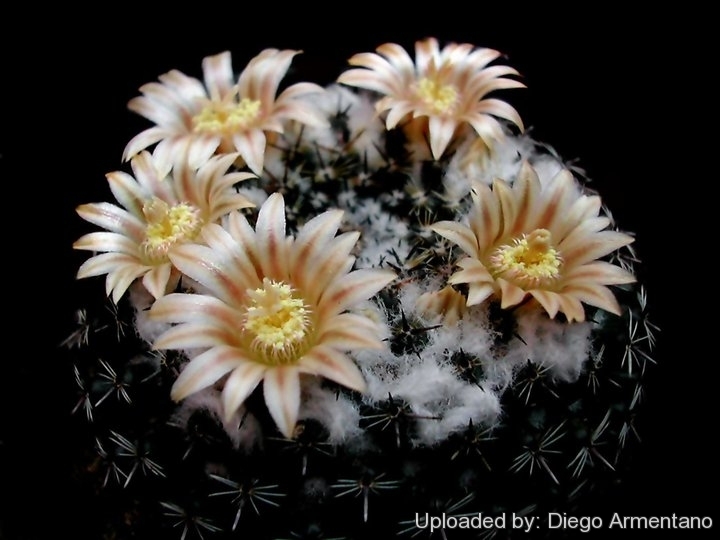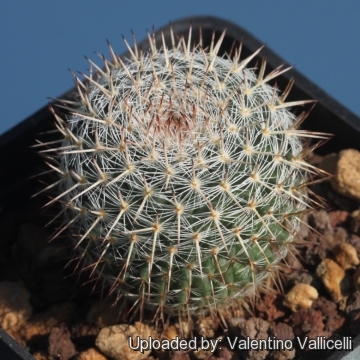Accepted Scientific Name: Mammillaria formosa subs. chionocephala (J.A.Purpus) D.R.Hunt
Mammillaria Postscripts 7: 3 (1998)

Mammillaria chionocephala (Mammillaria formosa subs. chionocephala) Photo by: Diego Armentano
Origin and Habitat: Highlands of central Mexico (Coahuila, Nuevo Leon, and Durango).
Type locality: Sierra de Parras, Coahuila, Mexico.
Altitude range: 1450-2400 metres above sea level.
Habitat and ecology: Mammillaria formosaSN|15832]]SN|15832]] subs. chionocephala grows in rocky areas together with Thelocactus macdowellii, Ferocactus steinesii, Hamatocactus hamatacanthus, Echinocactus horizonthaloniusSN|1711]]SN|1711]], Fouquieria splendensSN|15717]]SN|15717]], Thelocactus phymatothele, Neolloydia conoideaSN|10089]]SN|10089]], Agave striataSN|562]]SN|562]], Yucca filifera, Ariocarpus retususSN|2079]]SN|2079]] and Lophophora williamsiiSN|1117]]SN|1117]], amongst others.
Synonyms:
See all synonyms of Mammillaria formosa
Common Names include:
UKRAINIAN (Українська): Мамілярія xіоноцефала, Мамілярія сніжнобілоголова
Description: Mammillaria formosaSN|15832]]SN|15832]] subs. chionocephala (firstly described as Mammillaria chionocephalaSN|13998]]SN|15848]] by J.A.Purpus 1906) is an attractive globose pincushion cactus simple or rarely proliferous, sometimes 10 cm in diameter and typically wrapped on the upper part with a dense snow-white wool, so that only the tips of the tubercles visible. Each head is surrounded by a complete ring of star-like pink flowers. Even without flowers it is an extremely attractive plant, and one of the most beautiful mammillarias. Young plants start producing their wool only when they reach the flowering stage. There are several similar looking Mammillarias but far from being so woolly like the real "chionocephala".
Note. It was distributed by Pringle in 1890 as Mammillaria acanthophlegmaSN|15848]]SN|31354]] and has been in collections for many years. In 1906 Dr. J. A. Purpus described it as Mammillaria chionocephalaSN|31354]]SN|15848]]. It resembles very much a large plant of Mammillaria elegansSN|15848]]SN|13998]], but the tubercles are milky and bear dense hairs and wool in their axils. Some people consider Mammillaria formosaSN|15832]]SN|15832]] subs. chionocephala to be good species.
Stem: Symmetrical, solitary, slowly becoming branched, flattened-globular to short cylindrical, rounded or depressed at the summit, light to dark green, 15-20 cm high, 9-10 cm in diameter with a milky juice.
Tubercles: Tubercles arranged in 13-21 series, low, crowded, obtusely tetragonal-pyramidal, very milky, axils of tubercles densely filled with white wool and numerous hair-like bristles up to 20 mm long.
Radial spines: 22-24, occasionally as many as 40, rigidly bristle-like, white, to 8 mm long, somewhat pectinate, spreading.
Central spines: Usually 2-4, rarely as many as 7, straight or somewhat curved, more or less divergent, much stouter than the radials, rigid, white with brownish tips.
Flowers: About 1 cm long and in diameter, white to rose-red, in a circle near the summit.
Blooming season: Spring.
Fruit: Clavate, carmine red, to 10 mm long.
Seeds: Small, brown.
Subspecies, varieties, forms and cultivars of plants belonging to the Mammillaria formosa group
 Mammillaria formosa Galeotti ex Scheidw.: has pale pink flowers and 20-22 white radial spines. Distribution: Coahuila, Aguascalientes, Guanajuato, Zacatecas, Tamaulipas, Nuevo Leon, and San Luis Potosi.
Mammillaria formosa Galeotti ex Scheidw.: has pale pink flowers and 20-22 white radial spines. Distribution: Coahuila, Aguascalientes, Guanajuato, Zacatecas, Tamaulipas, Nuevo Leon, and San Luis Potosi. Mammillaria formosa subs. chionocephala (J.A.Purpus) D.R.Hunt: is typically wrapped on the upper part with a dense snow-white wool, so that only the tips of the tubercles visible. Distribution: Highlands of central Mexico (Coahuila, Nuevo Leon, and Durango).
Mammillaria formosa subs. chionocephala (J.A.Purpus) D.R.Hunt: is typically wrapped on the upper part with a dense snow-white wool, so that only the tips of the tubercles visible. Distribution: Highlands of central Mexico (Coahuila, Nuevo Leon, and Durango). Mammillaria formosa subs. microthele (Muehlenpf.) D.R.Hunt: has nearly pure white flowers and 22-24 flattened and bristle-like radials. Description: Coahuila, Guanajuato, Tamaulipas, and San Luis Potosi.
Mammillaria formosa subs. microthele (Muehlenpf.) D.R.Hunt: has nearly pure white flowers and 22-24 flattened and bristle-like radials. Description: Coahuila, Guanajuato, Tamaulipas, and San Luis Potosi. Mammillaria formosa subs. microthele var. superfina hort.: it is a particular nice selected form with very small tubercles and spines.
Mammillaria formosa subs. microthele var. superfina hort.: it is a particular nice selected form with very small tubercles and spines. Mammillaria formosa subs. pseudocrucigera (R.T.Craig) D.R.Hunt: has distinctly pink flowers with white margins and only 18 radials, often lacking on mature areoles. Distribution: Queretaro and Guanajuato.
Mammillaria formosa subs. pseudocrucigera (R.T.Craig) D.R.Hunt: has distinctly pink flowers with white margins and only 18 radials, often lacking on mature areoles. Distribution: Queretaro and Guanajuato.
Bibliography: Major references and further lectures
1) Fitz Maurice, B, Fitz Maurice, W.A., Hernández, H.M., Sotomayor, M. & Smith, M. 2013. Mammillaria formosa. The IUCN Red List of Threatened Species. Version 2015.2. <www.iucnredlist.org>. Downloaded on 18 July 2015.
2) David Hunt, Nigel Taylor “The New Cactus Lexicon” DH Books, 2006
3) Edward F. Anderson “The Cactus Family” Timber Press, 2001
4) James Cullen, Sabina G. Knees, H. Suzanne Cubey “The European Garden Flora Flowering Plants: A Manual for the Identification of Plants Cultivated in Europe, Both Out-of-Doors and Under Glass”Cambridge University Press, 11/August/2011
5) Nathaniel Lord Britton, Joseph Nelson Rose “Cactaceae: Descriptions and Illustrations of Plants of the Cactus Family” vol. 4 The Carnegie Institution of Washington, Washington 1923
6) Bulletin of Miscellaneous Information, page 71, H.M. Stationery Office, 1974
7) Kakteen und andere Sukkulenten, Volume 53, page 126, Steinhart KG, 2002
8) Alfred Byrd Graf “Exotica 3: Pictorial Cyclopedia of Exotic Plants from Tropical and Near-tropic Regions : 12,000 Illustrations, 204 Plants in Color, Guide to Care of Plants Indoors, Horticultural Color Guide, Plant Geography” Parte 2 Roehrs Company, 1976
 - A young specimen still without wool in the axils of tubercles. (Mammillaria formosa subs. chionocephala) Photo by: Valentino Vallicelli
- A young specimen still without wool in the axils of tubercles. (Mammillaria formosa subs. chionocephala) Photo by: Valentino VallicelliSend a photo of this plant.The gallery now contains thousands of pictures, however it is possible to do even more. We are, of course, seeking photos of species not yet shown in the gallery but not only that, we are also looking for better pictures than those already present.
Read More... Cultivation and Propagation: Mammillaria formosaSN|15832]]SN|15832]] subs. chionocephala is easy to cultivate and make interesting specimens for any collection, and over time (in 12-15 years) it may form colonies up to 50 cm or more in diameter, and doesn't require any special treatment, except for the need for frequent transplanting, in order to manage its exuberance. It needs as much light as possible without burning the plant, to keep the stems compact. Provide a well-drained soil mix. Water well and then allow to dry thoroughly before watering again during the growing season. It doesn't like much, if any, winter water, but can survive short exposures to freezing temperatures (-4° C.) if properly hardened off and kept dry.
Propagation: It is best propagated from seed. Seed readily germinates at 20°-22°C, or by offsets if available. The white wool between the areoles makes this species a pleasure to look at and grow, but the diversity among individual specimens is considerable and the best plants have abundant white axillary wool. Hence, it is worth raising a batch of seedlings and selecting one or two that have the most wool.











